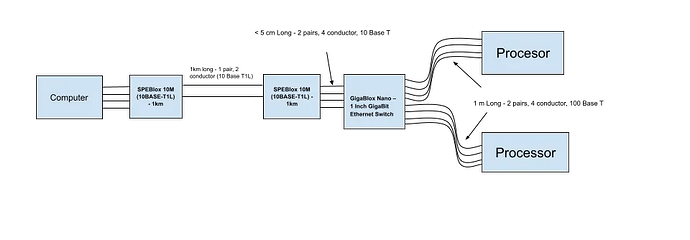Thanks for sharing the diagram. Your setup looks good, and using 10BASE-T1L for the 1 km tether is a good approach for low-speed data such as sensor and compressed video. I’ve added some notes below on the main points and a few potential issues to be aware of.
- Application overview
The topology you’ve proposed (SPEBlox 10M → GigaBlox Nano → processors) is workable, but there is an interface mismatch to be aware of.
SPEBlox 10M converts between 10BASE-T1L and 10BASE-T. 10BASE-T is carried on four Ethernet pins, while the GigaBlox Nano’s ports are 10/100/1000BASE-T which uses eight pins.
Normally you can connect four pins of an eight pin ethernet interface, and the speed will auto-negotiate down to the next fastest speed available which is 100BASE-T.
However in this case you actually want it to go down to 10BASE-T so it is compatible with SPEBlox Long. This means fixing the port speed on GigaBlox Nano manually, something that isn’t possible on that board.
To make this work, you’d need to use a switch that allows you to manually set the port speed. SwitchBlox Industrial can do this. SwitchBlox Industrial version allows you to force the port mode to 10BASE-T, ensuring compatibility with the SPEBlox Long.
- High-density connector for SPE
At present, SPEBlox 10M doesn’t use the same high-density board-to-board connector found on GigaBlox Nano. In other words, it’s not mountable. We could release one but we normally like to look at potential order volumes before we consider that. Can you share that information?
- Combined SPE + switch option
We don’t currently offer a single board that combines the 10BASE-T1L interface and a multi-port Ethernet switch, but this is something we can support as a custom PCB. Again, if you could share a little more about your potential order volumes that would be helpful.
- Connectors and cabling
SPE side: Use a Single-Pair Ethernet (IEC 63171-6) connector or a shielded two-pin terminal if you’re terminating inside an enclosure.
100BASE-TX side: SPEBlox Long contains transformers onboard so you don’t need to add more magjacks. Same is true of SwitchBlox Industrial. With Gigablox Nano, there are no transformers, but since there are transformers on SPEBlox Long, and both GigaBlox Nano and SPEBlox Long are voltage mode, you could get away with not adding them to the GigaBlox Nano side. Though this is a moot point because GigaBlox Nano can’t be used with SPEBlox Long for the aforementioned reason.
Cable: For the 1 km run, use a shielded single-pair cable rated for 10BASE-T1L, typically 18–22 AWG, 100 Ω impedance, and low capacitance. Choose a jacket suitable for your environment (PUR/TPU for robotics tethers).
